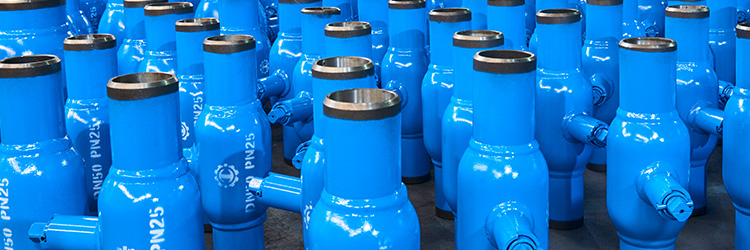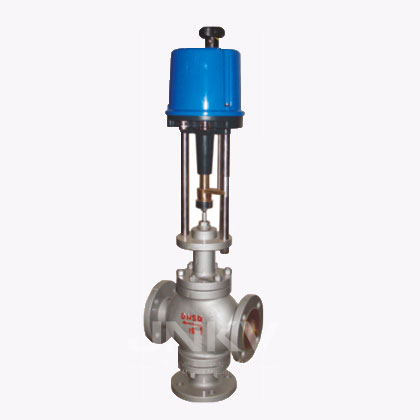

 Return
Return

Product overview
The electric three-way regulating valve is composed of a direct-stroke electronic electric actuator and a three-way confluence (diversion) valve with a cylindrical thin-walled window-shaped spool. It has compact structure, light weight, sensitive action and accurate flow characteristics. It can be controlled by control signals such as 4-20mA DC 0-10mA DC or 1-5V DC and single-phase power supply. It realizes automatic regulation and control of process pipeline fluid medium. It is widely used in precise control of gas, liquid, steam and other intermediaries. The quality parameters such as pressure, flow rate, temperature and liquid level are kept at a given value. Suitable for two-way outflow of a fluid through a three-way valve or the combination of two fluids into a fluid through a three-way valve.
Classification and Structural Characteristics of Electric Three-way Regulating Valve
Electric three-way regulating valves can be divided into two types: confluence valves and diversion valves according to the mode of fluid action. The confluence valve has two inlets and flows out from an outlet after confluence. The diversion valve has a fluid inlet and flows out of the two outlets by diverting into two streams. The structure of the combined three-way regulating valve is similar to that of the shunt three-way regulating valve. Its characteristics are as follows:
1. Electric three-way regulating valve has two spools and seats, which are similar to two-seat valves. However, when the flow area between one spool and seat increases, the flow area between the other spool and seat decreases. In the two-seat valve, the flow area between the two spools and the seat increases or decreases at the same time.
2. The air-opening and air-closing of electric three-way regulating valve can only be realized by choosing the positive and negative effects of the actuator. The change of air opening and air closing of two-seat valve can directly buy the valve body or spool and the valve seat in reverse.
3. When the electric three-way regulating valve is used in the control system requiring fluid proportioning, because it replaces an air-opening control valve and an air-closing control valve, the cost can be reduced and the installation space can be reduced.
4. Electric three-way regulating valves are also used in bypass control places, for example, one way of fluid heat transfer through heat exchangers, the other way of fluid does not heat transfer. When the electric three-way regulating valve is in front of the heat exchanger, the shunt three-way regulating valve is used; when the three-way regulating valve is installed behind the heat exchanger, the combined electric three-way regulating valve is used. Because the fluids flowing through the three-way valve installed in front of the heat exchanger have the same temperature, the leakage rate is smaller; the fluids flowing through the three-way valve installed in the heat exchanger have different temperatures, and the expansion degree of the valve core and seat is different, so the leakage rate is larger. Generally, the temperature difference between the two fluids should not exceed 150 C.
Three-way regulating valve with cage structure, balancing hole and cage guide is adopted. Therefore, the unbalanced force can be greatly reduced. Early three-way control valves used thin-walled cylinder windows and side-oriented spool. Although the unbalanced force can be reduced, there is still a large unbalanced force when a stream of fluid is close to closing (closing flow direction). Moreover, with the change of valve opening, the unbalanced force changes. The use of valve cage structure with balancing hole can make the unbalanced force dissipated. Besides, it has damping effect, which is beneficial to the stable operation of the control valve.
Because of the large leakage of electric three-way regulating valve, two control valves (and two-way nozzles) can be used to divert, or confluence, or to control the proportion of fluids in applications requiring small leakage.
Product valve body
Type: Three-way Casting Electric Three-way Regulating Valve
Nominal Path: DN20-DN200
Nominal Pressure: ANSI150, 300, 600LB JIS10, 16, 20, 30, 40K PN1.6, 2.5, 4.0, 6.4MPa
Connection mode: flange: FF, RF, RJ and LG
Flange standard: ANSI B16.5, JIS B2201 JB/T79.1 PN1.6MPa, JB/T79.2
Thread: DIN, NPT, RC, BSP, G, etc.
Welding: GB12224-89
Sealing surface form: PN16 convex surface, PN40 concave surface
Material: WCB, 304, 316, 316L
Upper cover: Standard type (-20 ~200 ~C) low temperature type (-60 ~196 ~C) heat dissipation type (-40 ~450 ~C)
Bellows sealing type
Cover Form: Plate Form
Filler: V-type fluorotetrafluoroethylene, flexible graphite
Valve components
Core type: single-seat plunger type
Core seat: 304, 316 + STL
Flow Characteristics: Equal Percentage, Linearity, Quick Opening
Executing agency
Form: Electric Actuator
Form of action: positive and negative
Control mode: proportional regulation or switching mode
Input signal: 4-20Ma, 0-10V, 1-5V, ON-OFF
Output signal: 4-20 mA or passive contact signal
Power supply: AC220V, AC380V, DC24V, etc.
Explosion-proof grade: ExdIIBT4, ExdIICT6 or other (optional)
Manual device: with handle
Annex (Configuration as required)
Heater, Overload Protection
Product performance
Rated KV: Reference Table
Flow characteristics: linear, equal percentage, fast opening
Adjustable range: 30:1
Leakage Grade: Metal Seal: Less than 0.01 (ANSI B16.104-1976IV) Soft Seal: Less than 0.00001%
Backlash: less than 1% of the total travel (with locator) less than 3% - 5% of the total travel (without locator)
Basic error: less than full range (+1%) with locator and less than full range (+5%) (without locator)